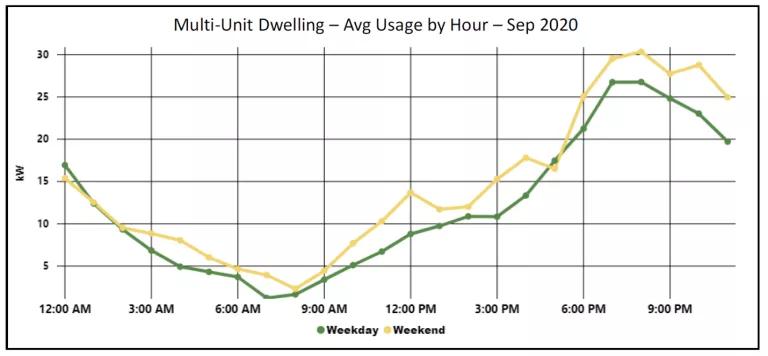
Charging an electric vehicle (EV) at noon when solar generation is abundant or after midnight when there’s excess capacity on the grid isn’t the same as charging in the early evening when people return home and total demand for electricity peaks—but the price to fill up an EV doesn’t always reflect that.
At many locations, utility customers pay for their electricity based on the total amount of electricity they use in a given month, regardless of when they use it. Utilities need to do more to ensure that customers with EVs take service on “time-of-use” (TOU) rates that encourage drivers to charge when the grid is not strained and electricity is the cheapest (increasing fuel cost savings relative to gasoline). Such rates are extremely effective at moving residential EV charging to “off-peak” hours when people are sleeping and there is plenty of spare capacity on the grid. Charging during off-peak hours brings in more revenue than associated costs, providing net-revenue that is returned to all utility customers in the form of lower rates and bills.
But what happens if the utility customer who gets the utility bill isn’t the one who is actually charging the car, truck, or bus? At most public charging sites, workplaces or multi-family locations, the site-operator is the one who gets the utility bill. And even if they get billed on a TOU rate, they may not pass those time-variant price signals onto the EV drivers who are the ones who actually decide when to charge.
Like a circuit with a split connection, the utility can send the signal all it wants, but it won’t be delivered unless the property owner transmits it to the driver.
What happens when that circuit is broken? EV drivers who aren’t given a reason to do otherwise will predictably charge as soon as they arrive at their destination, regardless of grid conditions.
For example, participants in Southern California Edison’s (SCE) “Charge Ready” pilot that helped customers install charging stations at workplaces, multi-unit dwellings, and other locations were required to take service on TOU rates but were not required to pass those time-variant price signals through to drivers, resulting in charging patterns that do not correspond to grid conditions, as illustrated in the figures below.


At workplaces, drivers charge as soon as they arrive at work, with demand peaking at 9 a.m., with the bulk of charging complete before noon, which means those vehicles aren’t available to absorb California’s abundant solar generation during afternoon hours. At multi-unit dwellings, drivers charge as soon as they arrive at home in the evening, with demand peaking at 7 p.m. (exacerbating system-wide peak demand), the bulk of charging complete before 1 a.m., and very little charging occurring in the early morning hours when the system is significantly underutilized.
Compare these charging patterns to households in SCE territory taking service on TOU rates who see the time-variant price signals directly. They charge almost exclusively during off-peak hours after 10 PM (hour 22 in the figure below).

The nudge that time-variant rates provide can also be effective outside the single-family residential context, as evidenced by the results of a program done in a neighboring service territory by San Diego Gas & Electric (SDG&E). In SDG&E’s “Power Your Drive” workplace and multi-unit dwelling charging station deployment program, site hosts were given the choice to have the utility’s dynamic time-variant rate passed through directly to EV drivers or to take service on that dynamic rate but implement alternative end-use pricing to drivers. The vast majority chose to pass through the time-variant price signals directly to EV drivers, and, as result, 90 percent of EV charging at those sites occurs during off-peak hours.
Passing Best Practices On
People or companies installing charging stations on their own dime are free to do whatever they want, but when charging stations are installed with the support of public or utility customer dollars, it’s doubly important to ensure the resulting charging supports and does not strain the grid.
Thankfully, utilities and regulators across the country are increasingly requiring site hosts to pass through price signals as a condition of participation in utility customer-funded infrastructure programs. In designing its successor to the Charge Ready pilot, SCE built upon the lessons from its own pilot and SDG&E’s, establishing a default arrangement in which site hosts pass TOU price signals directly through to drivers. In approving that program, the California Public Utilities Commission explicitly found that:
“Establishing a default arrangement that site hosts pass through TOU price signals to drivers would promote charging in a manner that is consistent with grid conditions, offer the opportunity for drivers to realize fuel cost savings, and preserve flexibility to accommodate site host operational needs.”
And in a more recent decision, the Commission made it clear that all future utility programs will need to incorporate the same requirements.
The Minnesota Public Utilities Commission also saw the necessity of adopting such an arrangement in approving an Xcel Energy EV charging program, while the Colorado Public Utilities Commission directed Xcel to require site hosts to pass through price signals across the board, without exception.
Charging stations installed with the support of utility customer funds should convey price signals to drivers that both increase fuel cost savings and encourage charging behavior that supports the grid to the benefit of all utility customers. If signals are not passed through to the drivers who decide when to charge, then charging behavior will not be affected and neither the grid nor drivers will benefit.
In short, TOU price signals are a powerful tool for encouraging drivers to charge in a manner that both supports the electric grid and maximizes fuel cost savings—but you have to pass them on.
